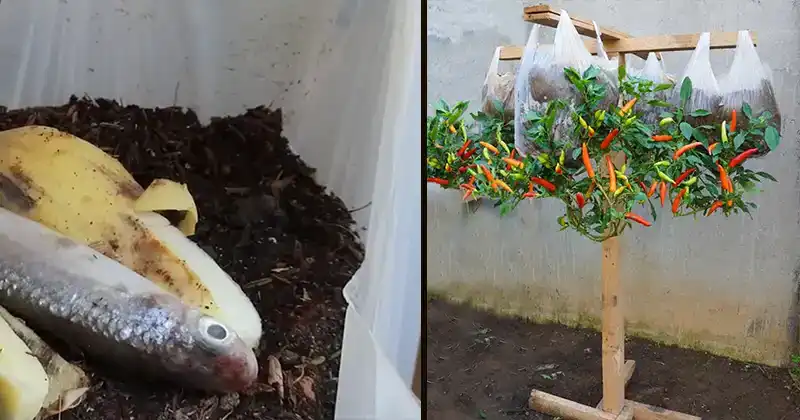Growing Peppers Upside Down in Grocery Bags: The Secret to an Abundant Harvest

When space is at a premium, and you yearn for a novel way to cultivate chili peppers, turning to the innovative technique of growing peppers upside down in grocery bags could be the answer. This creative gardening approach is not only space-efficient but also serves as a conversation starter. By suspending the bags and repurposing the top half of a 5L plastic bottle as a planter, you can effectively nurture chili pepper seedlings. In this article, we’ll guide you through the process, from preparing the bags and support structure to selecting the right soil and fertilizers for optimal growth.
Materials and Tools Needed:
- Grocery bags (doubled or tripled for extra strength)
- Wooden support structure
- Top half of a 5L plastic bottle
- Compost or potting soil
- Banana peels
- Fish remains (or fish emulsion)
- Phosphate fertilizer
- Chili pepper seedlings
- Watering can or hose
- Scissors
- Drill (for creating a hole in the bottom of the bags)
Step-by-Step Guide:
1. Select a Suitable Location:
Begin by choosing an ideal, sunny spot for your upside-down pepper garden. Pepper plants thrive in full sun, so ensure they receive a minimum of 6-8 hours of direct sunlight each day.
2. Prepare the Grocery Bags:
Double or triple up the grocery bags to bolster their durability, and if needed, nest one bag inside another to create additional layers. Use scissors to create a small hole in the center of the bag’s bottom, allowing passage for the plastic bottle and seedling.
3. Create the Support Structure:
Construct a robust wooden support structure to hold your grocery bags. This could be in the form of a sturdy wooden frame or a trellis, but ensure it is strong enough to support both the bags and the growing peppers. Attach hooks or other hangers to the structure for secure bag suspension.
4. Prepare the Plastic Bottle Planter:
Take the top half of a 5L plastic bottle and remove the cap. Insert your chili pepper seedling into the bottle through the cap hole, ensuring that the roots extend into the bottle. Fill the bottle with compost or potting soil, leaving a small gap at the top.
5. Insert the Bottle into the Bag:
Turn the bottle and seedling upside down, making sure that the seedling extends through the hole you made in the bottom of the bag. Carefully push the bottle through the hole until it is securely in place inside the bag.
6. Fertilize with Banana Peels:
Add a few banana peels into the bottle planter. Bananas are rich in potassium, a vital nutrient for pepper growth. These peels will decompose over time, gradually releasing nutrients into the soil.
7. Fertilize with Fish and Phosphate Fertilizer:
Supply your pepper plants with a balanced fish emulsion or fish remains as a source of nitrogen and other essential nutrients. Additionally, introduce a phosphate fertilizer to support root development and flowering, which is pivotal for pepper production.
8. Water Your Upside-Down Peppers:
Ensure your chili pepper plants are adequately watered, maintaining soil moisture without causing waterlogging. Excess water will drain from the bottom of the bag.
Maintenance:
As your peppers flourish, keep a watchful eye on their growth. Prune them as necessary to promote bushier growth and enhance fruit production. Continue to water and fertilize them regularly throughout the growing season.
9. Harvest Your Peppers:
As your peppers mature, they will change color, indicating their readiness for harvest. Gently pick the peppers to prevent harm to the plant.
Cultivating peppers upside down in grocery bags offers a creative and efficient gardening method for a fresh supply of chili peppers, even in limited space. This innovative approach not only optimizes space but also infuses a touch of ingenuity into your gardening endeavors. By following the outlined steps in this article, you’ll create a thriving upside-down pepper garden that’s bound to arouse curiosity and admiration among fellow gardening enthusiasts.



















